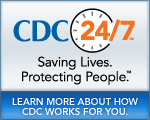Emerging Infectious Diseases Journal
Highlights: EID, Vol. 17, No. 7 (July 2011)
Disclaimer
The articles of interest summarized below will appear in the July 2011 issue of Emerging Infectious Diseases, CDC's monthly peer-reviewed public health journal. This issue will feature parasitic and tropical diseases. The articles are embargoed until Wednesday, June 15, 2011, at 12:00pm EDT.
Note: The EID journal publishes articles by scientists around the world, as well as CDC scientists. To correctly describe CDC's role, please clarify in your story whether a study was conducted by CDC or was conducted by the author's institution and published in CDC's Emerging Infectious Diseases journal.
1. Transmission of Influenza on International Flights, May 2009
A. R. Foxwell, et al.
Air travel is one of the fastest ways to spread infectious diseases around the globe; the rapid spread of pandemic flu in 2009 was a prime example. Preventing the spread of infection among air passengers involves contacting those who sat near symptomatic passengers. However, the definition of "near" varies according to how infectious the virus is and how much the passengers and crew move around. It also depends on the length of the flight and how good the air circulation is. A study of flights to Australia found that for flu, the risk zone is smaller than previously thought. On long flights, risk was higher for those sitting in a smaller square zone around a symptomatic passenger (2 seats to either side and 2 seats in front and behind) than in the larger linear zone previously used (2 rows on either side). Narrowing the zone, and thus the number of potentially exposed passengers, may speed the contact process so exposed passengers can get preventive health care sooner.
Contact:
Paul M. Kelly
Australian National University, National Centre for Epidemiology & Population Health, College of Medicine, Biology & Environment,
Eggleston Rd, Acton, Canberra Australian Capital Territory 0200, Australia;
+61 61255609
Paul.Kelly@anu.edu.au
2. Pandemic (H1N1) 2009 and Hajj Pilgrims who Received Pre-Departure Vaccination, Egypt
A. Kandeel, et al.
The annual Hajj pilgrimage to Saudi Arabia brings together more than 2.5 million people—and any infections they may have. In 2009, risks for infection during the Hajj were increased by high pandemic flu activity during that week. In Egypt, to protect the pilgrims themselves and to keep pandemic flu out of the country, all Hajj pilgrims were required to receive pandemic flu vaccination before departure. A survey of returning pilgrims found that although some became ill with seasonal flu, none became ill with pandemic flu. Thus, pre-departure vaccination may have been effective.
Contact:
Dr. Eman A. Kereem
Egyptian Ministry of Health
+ 20-10-1087323
The opinions expressed by authors contributing to this journal do not necessarily reflect the opinions of the U.S. Department of Health and Human Services, the Public Health Service, the Centers for Disease Control and Prevention, or the authors' affiliated institutions. Use of trade names is for identification only and does not imply endorsement by any of the groups named above.
- Historical Document: June 15, 2011
- Content source: Office of the Associate Director for Communication, Division of News and Electronic Media
- Notice: Linking to a non-federal site does not constitute an endorsement by HHS, CDC or any of its employees of the sponsors or the information and products presented on the site.
View Press Releases in
Get e-mail updates
To receive e-mail updates about this page, enter your
e-mail address:
Contact Us:
- Centers for Disease Control and Prevention
1600 Clifton Rd
Atlanta, GA 30333 - 800-CDC-INFO
(800-232-4636)
TTY: (888) 232-6348 - Contact CDC-INFO


